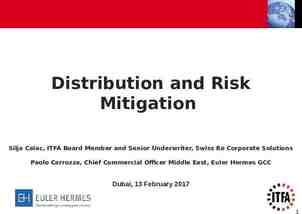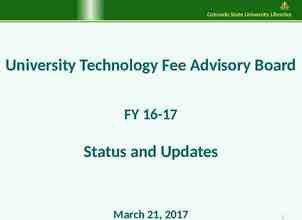U N Pe a c e ke e p i n g T O T M o d u l e 5 Training Delivery
31 Slides209.91 KB

U N Pe a c e ke e p i n g T O T M o d u l e 5 Training Delivery

Relevance Effective training delivery is essential to meet programme objectives The ability to communicate effectively, manage classroom dynamics and deliver content to diverse audiences is important for effective delivery UN Peacekeeping Training of Trainers 1

Module 5 Learning Objectives Learners will be able to: Demonstrate good practices of training delivery, including effective verbal and non-verbal communication, lesson pacing, time management, engaging diverse audiences and responding effectively to difficult situations Implement elements of the BOPPPS model into training delivery UN Peacekeeping Training of Trainers 2

Learning Overview I. Preparing for the Training II. Delivering the Training III. Classroom Management IV. After the Training UN Peacekeeping Training of Trainers 3

I. Preparing for the Training Prior to the training, the following preparations must be made: Environmen t Logistics Learners Yourself UN Peacekeeping Training of Trainers 4

Preparing the environment Room arrangement can have a significant impact on the training session. Seating should be arranged to support the learning objectives and the specific needs of your target audience. UN Peacekeeping Training of Trainers 5

Room arrangements U-shape X X X X X X X X X X X X X X X X X X X X X UN Peacekeeping Training of Trainers 6

Room arrangements Square or round X X X X X X X X X X X X X X X X X X X X X X X X UN Peacekeeping Training of Trainers 7

Room arrangements V-shape X X X X X X X X X X X X UN Peacekeeping Training of Trainers 8

Room arrangements Clusters X X X X X X X X X X X X X X X X X X X X X X X X X X UN Peacekeeping Training of Trainers X X X X X X 9

Room arrangements Classroom X X X X X X X X X X X X X X X X X X X X X X UN Peacekeeping Training of Trainers 10

Preparing the logistics Whenever possible, prepare logistics in advance of the start date of the training. Set up & test technology & equipment Connect with technical support (if available) Prepare back-up options in case of technology problems Familiarize yourself with building facilities UN Peacekeeping Training of Trainers 11

Preparing the learners Establish a connection with the participants prior to the training programme, e.g.: Survey or questionnaire Welcome email Avoid assigning lengthy amounts of reading prior to the training programme. UN Peacekeeping Training of Trainers 12

Preparing yourself Practice, practice, practice! Tips for practicing: Videotape yourself giving lectures Practice facilitating learning activities Ask for feedback on your delivery Time yourself UN Peacekeeping Training of Trainers 13

Establishing an effective learning environment is a continuous effort. It begins from the time participants arrive at the training facility until the closing of the training programme. UN Peacekeeping Training of Trainers 14

Maslow’s Pyramid of Needs Self-actualization Self-esteem (confidence, achievement) Social needs Safety and security Physiological needs (e.g. air, shelter, water, food) UN Peacekeeping Training of Trainers 15

II. Delivering the Training Setting the tone helps establish an effective learning environment. It also helps meet participants’ safety and social needs. UN Peacekeeping Training of Trainers 16

Delivering the Training Setting ground rules helps meet participants’ safety needs and contributes to the smoothness of the training. Ground rules should be: Participant-led Posted for the duration of the training programme Modified as needed UN Peacekeeping Training of Trainers 17

Delivering the Training Ice breakers help participants become better acquainted and thus help meet participants’ social needs. When choosing an ice breaker, take into account cultural, religious, gender and other considerations and participants’ prior relationships with one another. UN Peacekeeping Training of Trainers 18

Delivering the Training Learning objectives should be introduced at the beginning of the training and each lesson, along with the course schedule and other expectations. Participants should be clear about what type of work will be expected of them. UN Peacekeeping Training of Trainers 19

Delivering the Training Lectures should be kept short and to the point Tips for lecturing: Speak clearly & at an appropriate volume Use an engaging vocal tone Move around the room Integrate participants’ perspectives Integrate real life examples UN Peacekeeping Training of Trainers 20

Delivering the Training PowerPoint slides should be used effectively. Tips for using PowerPoint: Avoid too much text Do not read directly from the slides Use large font size and strong colour contrast Design for persuasion, not distraction Incorporate other types of visual aids UN Peacekeeping Training of Trainers 21

Delivering the Training Asking questions Close-ended: simple yes/no Open-ended: no right/wrong answer; require statement of opinion or explanation Leading: clearly intended answer Probing: intend to bring more information to light Hypothetical: promotes thinking about application UN Peacekeeping Training of Trainers 22

Delivering the Training Tips for asking questions: Give participants time to formulate a response Avoid calling on the same participants every time Find ways to engage all participants Be sensitive in correcting “wrong” answers Be a good listener UN Peacekeeping Training of Trainers 23

Delivering the Training Co-facilitating: when working with a cofacilitator, be sure to establish a clear division of responsibilities. Tips for co-facilitating Support whomever is taking the lead Spend time getting to know one another Take advantage of one another’s strengths Debrief after each session Avoid jumping in Stay focusedUNon whomever isTrainers presenting Peacekeeping Training of 24

Learning Activity 5.1 Practicing Training Delivery Instructions: Work in groups of 3-4 to practice delivering your individual lesson plans Videotape one another; watch the video later as part of your preparation for the final delivery Provide feedback to your peers Time: 60-90 minutes UN Peacekeeping Training of Trainers 25

III. Classroom Management Managing classroom dynamics is an important part of training facilitation. Classroom management includes things such as: Ensuring participants’ safety and wellbeing Encouraging active participation in lessons and activities Monitoring the pace and flow of discussions Managing potential disruptions UN Peacekeeping Training of Trainers 26

Learning Activity 5.2 Classroom Management Scenarios Instructions: Working in small groups, read through the classroom management scenarios Why is the problem occurring? What are dos and don’ts for managing the situation? Time: 25 minutes UN Peacekeeping Training of Trainers 27

IV. After the Training After the training, spend time reflecting: What worked well? When were there challenges? How was the pacing? Were participants engaged? Are ground rules being followed? Did you meet the learning objectives? Should anything be adjusted? UN Peacekeeping Training of Trainers 28

Summary In order to effectively facilitate a training, it is necessary to prepare the environment, the logistics, the participants and yourself Setting the tone at the beginning of the training is important to establishing an effective learning environment. Take time to break the ice, introduce training objectives and review expectations UN Peacekeeping Training of Trainers

Summary (cont.) Managing classroom dynamics includes things such as ensuring participants’ safety and wellbeing, encouraging active participation, monitoring the pace and flow of the lesson and managing potential disruptions It is a good idea to spend time in reflection after a training session or programme UN Peacekeeping Training of Trainers






